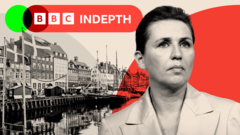BBC
Think, Denmark. Images of sleek, impossibly chic Copenhagen, the capital, might spring to mind. As well as a sense of a liberal, open society. That is the Scandinavian cliché.
But when it comes to migration, Denmark has taken a dramatically different turn. The country is now “a pioneer in restrictive migration policies” in Europe, according to Marie Sandberg, Director of the Centre for Advanced Migration Studies (AMIS) at the University of Copenhagen – both when it comes to asylum-seekers and economic migrants looking to work in Denmark.
Even more surprising, perhaps, is who is behind this drive. It’s generally assumed ‘far right’ politicians are gaining in strength across Europe on the back of migration fears, but that’s far from the full picture.
In Denmark – and in Spain, which is tackling the issue in a very different but no less radical way by pushing for more, not less immigration – the politicians taking the migration bull by the horns, now come from the centre left of politics.
How come? And can the rest of Europe – including the UK’s Labour government – learn from them?
Unsettling times in Europe
Migration is a top voter priority, right across Europe. We live in really unsettling times. As war rages in Ukraine, Russia is waging hybrid warfare, such as cyber attacks across much of the continent. Governments talk about spending more on defence, while most European economies are spluttering. Voters worry about the cost of living and into this maelstrom of anxieties comes concern about migration.
But in Denmark, the issue has run deeper, and for longer.
Immigration began to grow apace following World War Two, increasing further – and rapidly – in recent decades. The proportion of Danish residents who are immigrants, or who have two immigrant parents, has increased more than fivefold since 1985, according to the Migration Policy Institute (MPI).
A turning point was ten years ago, during the 2015 European migration and refugee crisis, when well over a million migrants came to Europe, mostly heading to the wealthier north, to countries like Denmark, Sweden and Germany.
Athanasios Gioumpasis / Getty
Denmark allowed authorities to confiscate asylum seekers’ jewellery and valuables
Slogans like “Danskerne Først” (Danes First) resonated with the electorate. When I interviewed supporters of the hard-right nationalist, anti-immigration, Danish People’s Party (DPP) that year they told me, “We don’t see ourselves as racists but we do feel we are losing our country.”
Denmark came under glaring international attention for its hardline refugee stance, after it allowed the authorities to confiscate asylum seekers’ jewellery and other valuables, saying this was to pay towards their stay in Denmark.
The Danish immigration minister put up a photo of herself on Facebook having a cake decorated with the number 50 and a Danish flag to celebrate passing her 50th amendment to tighten immigration controls.
And Danish law has only tightened further since then.
Plans to detain migrants on an island
Mayors from towns outside Copenhagen had long been sounding the alarm about the effects of the speedy influx of migrants.
Migrant workers and their families had tended to move just outside the capital, to avoid high living costs. Denmark’s famous welfare system was perceived to be under strain. Infant schools were said to be full of children who didn’t speak Danish. Some unemployed migrants reportedly received resettlement payments that made their welfare benefits larger than those of unemployed Danes, and government statistics suggested immigrants were committing more crimes than others. Local resentment was growing, mayors warned.
Today Denmark’s has become one of the loudest voices in Europe calling for asylum seekers and other migrants turning up without legal papers to be processed outside the continent.
The country had first looked at detaining migrants without papers on a Danish island that used to house a centre for contagious animals. That plan was shelved.
Then Copenhagen passed a law in 2021 allowing asylum claims to be processed and refugees to be resettled in partner countries, like Rwanda. The UK’s former Conservative government attempted a not dissimilar plan that was later annulled.
Copenhagen’s Kigali plan hasn’t progressed much either but it’s tightened rules on family reunions, which not long ago, was seen as a refugee’s right. It has also made all refugees’ stay in Denmark temporary by law, whatever their need for protection.
But many of Denmark’s harsh measures seemed targeted as much at making headlines, as taking action. The Danish authorities intentionally created a “hostile environment” for migrants”, says Alberto Horst Neidhardt, senior analyst at the European Policy Centre.
And Denmark has been keen for the word to spread.
AFP via Getty
Denmark placed adverts in Lebanese newspapers warning how tough Danish migration policies were
It put advertisements in Lebanese newspapers at the height of the migrant crisis, for example, warning how tough Danish migration policies were.
“The goal has been to reduce all incentives to come to Denmark,” says Susi Dennison, senior policy fellow at the European Council on Foreign Relations.
“The Danes have gone further than most European governments,” she explains. Not just honing in on politically sensitive issues like crime and access to benefits but with explicit talk about a zero asylum seekers policy.
And yet “before the 2015 refugee crisis, there was a stereotype of Nordic countries being very internationalist… and having a welcoming culture for asylum seekers,” says Ms Denniso
Read More





